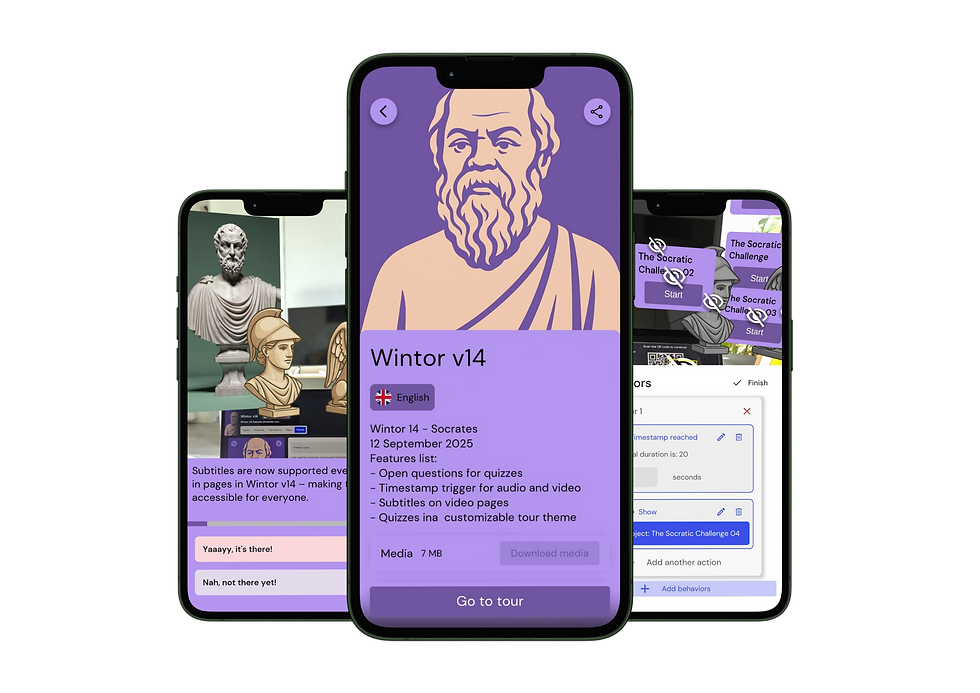Self-Guided Tours as the Future of Content
- Wouter Kayser

- Aug 20
- 3 min read
In our age of information overload, creating content that truly engages audiences has become increasingly challenging. While we're surrounded by endless streams of articles, videos, and podcasts, there's one format that's quietly revolutionizing how we consume and interact with information: the self-guided digital tour.
Think about it – when was the last time you finished reading a 3,000-word article? Or watched a 45-minute webinar without checking your phone? Digital tours solve the engagement crisis by borrowing the best elements from traditional storytelling and combining them with modern technology. Here's why they're so effective:
Structured Yet Flexible Experience
Self-guided digital tours strike the perfect balance between guidance and freedom. Like a well-crafted PowerPoint presentation, they provide a familiar structure that users intuitively understand – there's a clear beginning, middle, and end that creates a satisfying sense of completion.
But unlike rigid presentations, tours offer flexibility. Users can skip ahead to the sections that most interest them without losing the overall narrative thread. This familiar navigation style reduces cognitive load because people know what to expect. They're not wrestling with complex interfaces or wondering where to click next – they can focus entirely on the content itself.
This structure also creates natural stopping points. Users can pause their journey, return to their day, and pick up exactly where they left off. It's the digital equivalent of bookmarking a page, but with the added benefit of context and continuity.
Perfect Content Packaging
We live in an era of shrinking attention spans, and digital tours are perfectly designed for how modern brains process information. Each "stop" on the tour delivers bite-sized chunks of content – just enough to be meaningful and memorable, but not so much that it becomes overwhelming.
This packaging approach is fundamentally different from long-form content that dumps everything at once. Instead of forcing users to wade through dense paragraphs or sit through lengthy videos, tours break information into digestible pieces. Each segment has a clear purpose and builds naturally to the next.
The beauty is in the pacing. Users can absorb one piece of information, process it, maybe even act on it, before moving to the next section. It's like having a conversation with an expert who knows exactly when to pause and let ideas sink in.
Immersive Storytelling
Digital tours transform passive content consumption into active exploration. They create contained, purposeful narratives that have been thoughtfully designed with ideal duration and pacing in mind. This isn't accidental – it's storytelling at its finest.
Unlike articles or videos where users are detached observers, tours make people participants in the experience. Whether they're exploring a museum, learning about a product, or discovering a new city, users become part of the story. They're not just reading about something; they're experiencing it.
This immersive quality comes from the combination of physical or visual context with digital enhancement. A tour about architecture doesn't just describe building techniques – it shows you the building, points out specific details, and helps you understand why those choices matter. The story unfolds in real space and real time, creating connections that purely digital content simply can't match.
## Accessible and Inclusive Design
Perhaps most importantly, self-guided digital tours remove barriers that other content formats create. They're available 24/7 without scheduling constraints – no missing live webinars or coordinating calendars. Users engage at their own pace, accommodating different learning speeds, physical abilities, and available time.
The technology integration is seamless rather than intimidating. GPS navigation, QR codes, and interactive elements feel natural and helpful rather than complex. These tools remove friction instead of adding it, making the experience accessible to users regardless of their technical comfort level.
Tours also serve different learning preferences simultaneously. Visual learners get maps and images, auditory learners can listen to narration, and kinesthetic learners engage through movement and interaction. It's inclusive design that doesn't sacrifice quality for accessibility – it enhances the experience for everyone.
The Future of Engagement
Self-guided digital tours represent a fundamental shift in how we think about content delivery. They respect users' time, intelligence, and preferences while still providing rich, meaningful experiences. In a world where attention is the most valuable currency, tours offer a way to earn and keep that attention through quality, not tricks.
As we continue to navigate the digital landscape, the formats that will thrive are those that understand human nature – our need for story, structure, and control over our own learning journey. Digital tours deliver on all three, creating experiences that users actually want to complete rather than content they feel obligated to consume.
The question isn't whether self-guided digital tours will become more popular – it's whether other content formats can adapt quickly enough to keep up



Comments